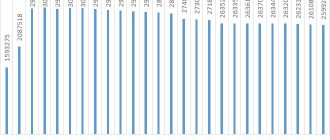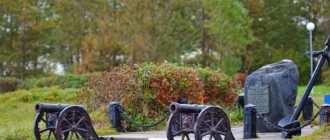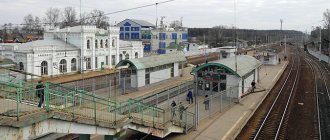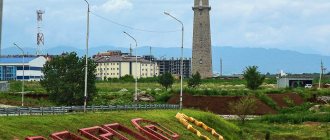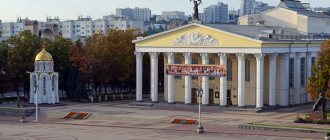This term has other meanings, see Dmitriev.
| City Dmitriev Coat of arms |
| A country | Russia, Russia |
| Subject of the federation | Kursk regionKursk region |
| Municipal district | Dmitrievsky |
| urban settlement | Dmitriev city |
| Coordinates | 52°07′44″ n. w. 35°04′32″ E. long / 52.12889° north w. 35.07556° E. d. / 52.12889; 35.07556 (G) [www.openstreetmap.org/?mlat=52.12889&mlon=35.07556&zoom=12 (O)] (Z)Coordinates: 52°07′44″ N. w. 35°04′32″ E. long / 52.12889° north w. 35.07556° E. d. / 52.12889; 35.07556 (G) [www.openstreetmap.org/?mlat=52.12889&mlon=35.07556&zoom=12 (O)] (I) |
| Chapter | Ryabykin Alexey Vasilievich[1] |
| Former names | until 1784 - Dmitriev until 1940 - |
| City with | 1779 |
| Square | 8 km² |
| Center height | 190 |
| Population | ↘6761[2] people (2016) |
| Density | 845.13 people/km² |
| Names of residents | Dmitrievtsy, Dmitrievets |
| Timezone | UTC+3 |
| Telephone code | +7 47150 |
| Postcode | 307500 |
| Vehicle code | 46 |
| OKATO code | [classif.spb.ru/classificators/view/okt.php?st=A&kr=1&kod=38208501 38 208 501] |
| Official site | [dmitriev4605.rkursk.ru/index.php?mun_obr=68&sub_menus_id=608 v4605.rkursk.ru/index.php?mun_obr=68&sub_menus_id=608] |
| Dmitriev Moscow |
| Kursk Dmitriev Dmitriev |
Audio, photo and video
on Wikimedia Commons
Dmitriev
(in many official documents
Dmitriev-Lgovsky
) is a city (since 1779[3]) in Russia, the administrative center of the Dmitrievsky district of the Kursk region. The Dnieper basin is located on the banks of the Svapa River, 120 km from Kursk on the A-142 Trosna-Kalinovka highway, a railway station on the Bryansk - Lgov line. Population - 6761[2] people. (2016).
Story
Near the modern city there was the village of Dmitrievskoye
(now preserved under the name
Old Town
).
In 1779, the district town of Dmitriev
of the Dmitrievsky district of the Kursk governorship was formed.
In 1784, the city was renamed Dmitriev-on-Svap
(or
Dmitrosvapsk
) [4] - to distinguish it from the city of Dmitrovsk, Oryol province.
Official documents from the 1930s mention Dmitriev. In 1929, Dmitriev was called Dmitriev-Lgovsky
, since at that time the city belonged to the Lgovsky district (before that - in the Lgovsky district). There is no information about the official date of renaming the city[5].
At the end of the 19th century, there were 473 houses in the city, including 6 stone ones, and a women's gymnasium and a district school were opened. Factories operated: a flour mill, a hemp mill, a grain mill, two oil mills, and there was a brisk trade. Grain, hemp and timber were shipped at the river pier. Chalk mining was carried out on the territory of the city.
During the Great Patriotic War, the city was occupied on October 8, 1941, liberated on March 3, 1943[6].
The modern name of the city is Dmitriev (without the addition of “Lgovsky”), and the name “Dmitriev-Lgovsky” is the railway station. There are no official documents about the renaming of the city of Dmitriev to Dmitriev-Lgovsky and vice versa in the city museum, and they have not been found anywhere. In 1929, Dmitriev was called Dmitriev-Lgovsky according to the district, but there is no information about the renaming of the city to Dmitriev-Lgovsky. There is still confusion over the name of the railway station.
Soviet authority
If there were factories in the city, then there was a proletariat. The revolutionary movement of 1905, which shook Russia, did not pass by Dmitriev-Lgovsky. The peasants destroyed the manor's estates, took away grain, and cut down forests. The uprising was crushed by the troops that entered.
In December 1917, Soviet power came. In the first Soviet years, public life revived. Gradually, everything returned to normal: enterprises worked, grain was sown, five-year plans were fulfilled and exceeded. There were two cinemas, several schools, and a pedagogical college in the city.
Culture
- MUK "Dmitrievsky District House of Culture"
- Cinema center
Museums
- Dmitrievsky State Local Lore Museum named after. A.F. Wangenheim
Libraries
- Dmitrievsk City Library
- Children's library
City monuments
- Memorial complex “In memory of those who fell in the Great Patriotic War of 1941-1945.” No one is forgotten, nothing is forgotten"
- Monument to the partisans of the Great Patriotic War.
- Memorial "Glory to Soviet tank crews"
- Monument at the site of the execution of partisan Vera Tereshchenko.
Kursk
There are a great many small towns in Russia, but not everyone can boast that the estate of the brother of Emperor Nicholas II himself is located there. yes And not only that. After all, the writer Mikhail Gorbovtsev, a Stalin Prize laureate, Maria Nagibina, a famous Moscow State University breeder, Alexey Vangengeim, the founder of the USSR hydrometeorological service, lived and worked in the city of Dmitriev. But this is not all, because initially Dmitriev was located a little further from his current location, and then, for quite reasonable reasons, he moved. So, our story about the Dmitrievsky district. Who can best tell the history of the area? Of course, employees of the local history museum.
Merchant's house
With Alexey Shatalov, head of the Dmitrievsky Museum of Local Lore named after A.F. Wangenheim, a branch of the Kursk Regional Museum of Local Lore, we begin the conversation on the way to the ancient two-story building.
This house was built before the revolution by the merchant Khobotov.
“The merchant had three daughters, and all of them mastered the teaching profession,” says Alexey Vladimirovich, so the father built this building as a parish school and handed it over to the Intercession Church.
The house contained not only a school, but also apartments for the church clergy. After the revolution, the building was transferred to some other authorities, and in 1919 - to our museum.
This house also served well during the Civil War, as it housed the headquarters of the 14th Army, which was commanded by Grigory Ordzhonikidze himself.
“Our museum suffered greatly during the fascist occupation,” notes Alexey Shatalov, the fact is that the workers did not have time to take anything out of it. And the Germans simply plundered it. Valuables were stolen, and everything that was considered unnecessary was thrown away. A stable was set up on the first floor of the house.
It’s hard to even imagine how much effort it took museum workers to restore the exhibition, but it still happened and was even recorded by photographers during the first excursion after the war.
Starogorsk settlement
If the theater begins with a hanger, then the Dmitrievsky Museum begins with a painting. The impressively sized canvas by artist Grigory Kiselev depicts an ancient fortress.
“This is how the painter imagines our Starogorsk settlement, located in the village of Stary Gorod, the site of Dmitriev’s first location,” said Alexey Vladimirovich.
According to local historians, the fortress, which can still be seen now if you stretch your imagination, was built by the Prophetic Oleg, and it served as a defense for the first Slavs from the attacks of the Pechenegs and other nationalities.
The Starogorsk settlement was built among the hills, which is why five hills are drawn on the coat of arms of the Dmitrievsk region.
It is unknown whether the settlement was called Dmitriev. The museum staff even applied to the Russian Academy of Sciences to conduct research.
Scientists have found that the chronicles contain the following lines: “The Polovtsians came to fight against Dmitrov.” But it is unknown which Dmitriev they are talking about.
“They definitely excluded the Moscow Dmitrov, because he does not coincide with those events, but they also do not confirm the participation of our Dmitriev,” the museum director notes.
According to Alexey Vladimirovich, the eight-meter rampart and entrance to the fortress are still preserved in the Starogorsk settlement. And, judging by the size of the settlement, it was a very large defensive structure of the Slavic period, completely defeated by the Mongol-Tatars.
In response to my question about excavations, Alexey Shatalov replied that they once took place, as they say, at a minimum, but for global work very serious capital investments are required.
The city owes its name to the church in the name of Demetrius of Thessalonica.
As the Russian Academy of Sciences has established, the first mention of Dmitriev as a settlement dates back to September 1614.
The source says that there was such a village of Dmitrievskoye and it belonged to the Rylsky Nikolaevsky Monastery. At first it was small, just seven courtyards, and for two centuries a quiet, calm life flowed here. People were engaged in agriculture; beekeeping, that is, forest beekeeping, was very developed.
By the way, thanks to rich forest plantations, the Dmitrievsky region will become a partisan territory during the Great Patriotic War.
Then in 1764 the village was secularized, taken away from the monastery and became the economic village of Dmitrievsky.
In 1779, Dmitriev received the status of a county town. But due to the inconvenient location of the settlement in St. Petersburg, a plan was developed to move the city to another place.
The reason for this action was the inconvenient access to the settlement, says Alexey Shatalov, again, drinking water was difficult to obtain in the old place. And in 1785, Dmitriev moved to the current location. It is worth noting that in 1784 our city received the prefix “on Svapa” to distinguish it from Dmitrovsk Orlovsky. The distance here is small, and this caused confusion.
Your own Switzerland
Before the revolution, Dmitriev was considered one of the large districts of the Kursk province, and in Soviet times it was among the most advanced districts of the Kursk region.
“In those days, it was considered an honor to receive an assignment to our region after graduating from a university,” noted Alexey Vladimirovich.
The reason for this success was developed agriculture. There was a sugar factory in the area; by the way, before the revolution, the enterprise belonged to Mikhail Romanov, the brother of Nicholas II.
The museum has a photo taken during one of the Grand Duke’s visits to Dmitriev.
The estate of Mikhail Romanov still exists in the city. Not long ago, the district authorities cleared and beautified the park, which still “remembers” the Grand Duke. The house where Mikhail Alexandrovich stayed, built on the estate, has also been preserved.
But, unfortunately, the plant ceased to exist, although in Soviet times it continued to develop and was one of the largest sugar factories in the Northwestern District of the Kursk Region. Also in Dmitriev, a meat processing plant, a butter factory, a cannery, and a very large poultry farm operated successfully.
There was also a private brewery in the city. Local residents remember it from the first electrical advertisement. Many houses in Dmitriev were still illuminated with kerosene lamps, but on the building of the enterprise even at night the inscription “Beer of Russia” was visible. The townspeople organized entire excursions to this inscription, because at that time it was a curiosity.
“You see, here, like in Switzerland, everything was there,” my interlocutor notes.
The area was lucky to have famous people
— the head of the Dmitrievsky Museum of Local Lore sincerely remarks. Let's start, perhaps, with the founder of the museum, Alexei Vangengeim. Alexey Fedorovich created it in 1919. In addition, he was a physics teacher, and since 1929, the organizer and first head of the hydrometeorological service of the USSR.
Maria Nagibina lived and worked here, then worked in the botanical garden of Moscow State University, a famous breeder who bred several varieties of phlox and equipped Moscow parks.
In the Year of Literature, we cannot help but say that in the post-war period the museum was restored by Mikhail Gorbovtsev, a children's writer. He led it for many years. And Mikhail Maksimovich wrote one of his most famous works, “Mishka’s Childhood,” in the city of Dmitriev. For this work the writer was awarded the Stalin Prize.
White sparrow and astronaut spacesuit
Of course, the Dmitrievsky Museum also has unique exhibits. These include an ancient Russian sword from the 12th century.
- It was found back in 1946 on the outskirts of Dmitriev and handed over to the residents of the village of Krupets, and they already brought it to the museum, says Alexey Shatalov, for a long time it lay in storage until restoration was carried out, funds for which were allocated by the Kursk Culture Committee areas.
The craftsmen who cleaned the weapon of rust saw letters on one side, but did not read the inscription, and on the other there was an image of a cross and two marks in the form of archers.
A small highlight of the hall, which tells about the nature of the area, is the albino sparrow. By the way, in response to my question about why there are so many stuffed animals and birds in the museum, Alexey Shatalov answers that at one time the cultural institution had its own taxidermists on staff, who had permission to shoot rare animals.
The real decoration of the Dmitrievsky branch of the local history museum is, perhaps, the astronaut’s spacesuit.
“There is no such exhibit in any of the region’s museums anymore,” says the head of the museum; it’s just that at one time, when Boris Chukhraev was the first secretary of the district party committee, he invited two cosmonauts Valery Rozhdestvensky and Yuri Malyshev to Dmitriev. And they, in turn, invited our delegation to Star City, from where they brought the spacesuit.
By the way, this delegation included the first secretary of the Komsomol Alexander Mikhailov, now the governor of the Kursk region.
Land of Partisan Glory
When we enter the hall of the Great Patriotic War, Alexey Vladimirovich begins to talk about how Dmitriev is considered the land of partisan glory. One of the most famous partisans of the city is Vera Tereshchenko.
There was not just a large detachment here, it also carried out unique military operations, says my interlocutor.
The Dmitrievsky partisans even had their own oath.
-...I swear to mercilessly take revenge for the burned, devastated cities and villages, for the blood of our people. If it requires my life, I will give it without hesitation... there are such lines in it.
One of the most striking is the operation that was carried out in the village of Klishino during the liberation of Dmitriev. Our partisans would have recaptured this settlement from the enemy if fascist reinforcements had not arrived.
“Our fighters had already run out of ammunition, but the spirit was so strong that they went at the enemy with their bare hands, and this frightened the Germans, as a result of which the partisans won this battle,” says Alexey Vladimirovich.
Dmitrievites are proud that their district has nurtured and raised 15 Heroes of the Soviet Union and two full holders of the Order of Glory. If we compare with Kursk, then there are 18 Heroes of the Soviet Union.
By the way, the liberation of Dmitriev was very difficult - our troops could not recapture him from the Nazis for two whole weeks.
Among the wartime exhibits, a notebook covered in large letters is of particular interest. It is clear that the inscriptions were made in ink.
“This is a homemade primer from which the children of the Krupetsk school studied in 1943,” notes Alexey Shatalov, despite the war, people continued to live and wanted to be literate.
Nadezhda Glazkova
Notable natives
- Kolosov, Mitrofan Alekseevich - philologist.
- Feofan (Ashurkov Ivan Andreevich) - Metropolitan of Simbirsk and Novospassky.
- Yakovlev, Evgeniy Nikolaevich - Soviet oil and gas worker. Deputy Minister of Gazprom of the USSR (1986-1989). Hero of Socialist Labor (1986).
- German, Yuri Pavlovich - Russian and Soviet writer, playwright, screenwriter, laureate of the Stalin Prize of the second degree (1948). Born in Riga. Honorary resident of the city of Dmitriev.
- Solovyov, Dmitry Semyonovich - a prominent researcher of Antarctica, candidate of geological and mineralogical sciences.
- Rodin, Vyacheslav Georgievich - academician of the Russian Academy of Sciences, Honored Designer of the Russian Federation.
Notes
- [dmitriev-lgovskij.ru/administraciya-goroda-dmitrieva-kurskoj-oblasti/ Administration of the city of Dmitriev on the reference and information website]
- ↑ 123
www.gks.ru/free_doc/doc_2016/bul_dr/mun_obr2016.rar Population of the Russian Federation by municipalities as of January 1, 2021 - THE USSR. Administrative-territorial division of the union republics on January 1, 1980 / Compiled by V. A. Dudarev, N. A. Evseeva. - M.: Publishing house "Izvestia of the Soviets of People's Deputies of the USSR", 1980. - 702 p. — P. 157.
- Dmitriev-on-Svape // Encyclopedic Dictionary of Brockhaus and Efron: in 86 volumes (82 volumes and 4 additional). - St. Petersburg, 1890-1907.
- [dmitriev4605.rkursk.ru/index.php?mun_obr=68&sub_menus_id=608 Official website of the municipal formation "G. Dmitriev"]
- Cities of Russia: encyclopedia / Ch. ed. G. M. Lappo. - M.: Great Russian Encyclopedia, 1994. - 559 p.: ill., maps.
- ↑ 123456789101112131415161718192021
[www.MojGorod.ru/kursk_obl/dmitriljgov/index.html People's encyclopedia “My City”. Dmitriev (city)]. Retrieved January 25, 2014. [www.webcitation.org/6MtHPEWGO Archived from the original on January 25, 2014]. - [www.perepis2002.ru/ct/doc/1_TOM_01_04.xls All-Russian Population Census 2002. Volume. 1, table 4. Population of Russia, federal districts, constituent entities of the Russian Federation, districts, urban settlements, rural settlements - regional centers and rural settlements with a population of 3 thousand or more]. [www.webcitation.org/65AdCU0q3 Archived from the original on February 3, 2012].
- [www.gks.ru/bgd/regl/B09_109/IssWWW.exe/Stg/d01/tabl-21-09.xls Number of permanent population of the Russian Federation by cities, urban-type settlements and districts as of January 1, 2009]. Retrieved January 2, 2014. [www.webcitation.org/6MJmu0z1u Archived from the original on January 2, 2014].
- [kurskstat.gks.ru/wps/wcm/connect/rosstat_ts/kurskstat/resources/ee617b804e86dcf6bf81ffb8fc91c3ba/vol+1.pdf All-Russian Population Census 2010. Volume 1. Number and distribution of the population of the Kursk region]. Retrieved January 31, 2014. [www.webcitation.org/6N2ZGXrqv Archived from the original on January 31, 2014].
- [www.gks.ru/free_doc/doc_2012/bul_dr/mun_obr2012.rar Population of the Russian Federation by municipalities. Table 35. Estimated resident population as of January 1, 2012]. Retrieved May 31, 2014. [www.webcitation.org/6PyOWbdMc Archived from the original on May 31, 2014].
- [www.gks.ru/free_doc/doc_2013/bul_dr/mun_obr2013.rar Population of the Russian Federation by municipalities as of January 1, 2013. - M.: Federal State Statistics Service Rosstat, 2013. - 528 p. (Table 33. Population of urban districts, municipal districts, urban and rural settlements, urban settlements, rural settlements)]. Retrieved November 16, 2013. [www.webcitation.org/6LAdCWSxH Archived from the original on November 16, 2013].
- [www.gks.ru/free_doc/doc_2014/bul_dr/mun_obr2014.rar Table 33. Population of the Russian Federation by municipalities as of January 1, 2014]. Retrieved August 2, 2014. [www.webcitation.org/6RWqP50QK Archived from the original on August 2, 2014].
- [www.gks.ru/free_doc/doc_2015/bul_dr/mun_obr2015.rar Population of the Russian Federation by municipalities as of January 1, 2015]. Retrieved August 6, 2015. [www.webcitation.org/6aaNzOlFO Archived from the original on August 6, 2015].
An excerpt characterizing Dmitriev (city)
Helen was in Erfurt during the famous meeting of the emperors, and from there she brought these connections with all the Napoleonic sights of Europe. In Erfurt it was a brilliant success. Napoleon himself, noticing her in the theater, said about her: “C'est un superbe animal.” [This is a beautiful animal.] Her success as a beautiful and elegant woman did not surprise Pierre, because over the years she became even more beautiful than before. But what surprised him was that during these two years his wife managed to acquire a reputation for herself “d’une femme charmante, aussi spirituelle, que belle.” [a lovely woman, as smart as she is beautiful.] The famous Prince de Ligne [Prince de Ligne] wrote eight-page letters to her. Bilibin saved his mots [words] to say them for the first time in front of Countess Bezukhova. To be received in the salon of Countess Bezukhova was considered a diploma of intelligence; young people read Helen's books before the evening so that they would have something to talk about in her salon, and the secretaries of the embassy, and even envoys, confided diplomatic secrets to her, so Helen had strength in some way. Pierre, who knew that she was very stupid, sometimes attended her evenings and dinners, where politics, poetry and philosophy were discussed, with a strange feeling of bewilderment and fear. At these evenings he experienced a feeling similar to that which a magician should experience, each time expecting that his deception would be revealed. But was it because stupidity was precisely what was needed to run such a salon, or because the deceived themselves found pleasure in this deception, the deception was not discovered, and Elena Vasilyevna Bezukhova’s reputation as d’une femme charmante et spirituelle was so unshakably established that she could speak the greatest vulgarities and stupidities, and yet everyone admired her every word and looked for a deep meaning in it, which she herself did not even suspect. Pierre was exactly the husband that this brilliant, society woman needed. He was that absent-minded eccentric, the husband of a grand seigneur [great gentleman], not bothering anyone and not only not spoiling the general impression of the high tone of the living room, but, with his opposite to the grace and tact of his wife, serving as an advantageous background for her. During these two years, Pierre, as a result of his constant concentrated occupation with immaterial interests and sincere contempt for everything else, acquired for himself in the company of his wife, who was not interested in him, that tone of indifference, carelessness and benevolence towards everyone, which is not acquired artificially and which therefore inspires involuntary respect . He entered his wife's living room as if he were entering a theatre, he knew everyone, was equally happy with everyone and was equally indifferent to everyone. Sometimes he entered into a conversation that interested him, and then, without consideration of whether les messieurs de l'ambassade [employees at the embassy] were there or not, mumbled his opinions, which were sometimes completely out of tune with the present moment. But the opinion about the eccentric husband de la femme la plus distinguee de Petersbourg [the most remarkable woman in St. Petersburg] was already so established that no one took au serux [seriously] his antics. Among the many young people who visited Helen’s house every day, Boris Drubetskoy, who was already very successful in the service, was, after Helen’s return from Erfurt, the closest person in the Bezukhovs’ house. Helen called him mon page [my page] and treated him like a child. Her smile towards him was the same as towards everyone else, but sometimes Pierre was unpleasant to see this smile. Boris treated Pierre with special, dignified and sad respect. This shade of respect also worried Pierre. Pierre suffered so painfully three years ago from an insult inflicted on him by his wife that now he saved himself from the possibility of such an insult, firstly by the fact that he was not his wife’s husband, and secondly by the fact that he did not allow himself to suspect. “No, now having become a bas bleu [bluestocking], she has abandoned her former hobbies forever,” he said to himself. “There was no example of bas bleu having passions of the heart,” he repeated to himself, from nowhere, a rule he had learned, which he undoubtedly believed. But, strangely, the presence of Boris in his wife’s living room (and he was almost constantly) had a physical effect on Pierre: it bound all his limbs, destroyed unconsciousness and freedom of his movements. “Such a strange antipathy,” thought Pierre, “but before I even really liked him.” In the eyes of the world, Pierre was a great gentleman, a somewhat blind and funny husband of a famous wife, a smart eccentric who did nothing, but did not harm anyone, a nice and kind fellow. During all this time, a complex and difficult work of internal development took place in Pierre’s soul, which revealed a lot to him and led him to many spiritual doubts and joys. He continued his diary, and this is what he wrote in it during this time: “November 24th. “I got up at eight o’clock, read the Holy Scriptures, then went to office (Pierre, on the advice of a benefactor, entered the service of one of the committees), returned to dinner, dined alone (the Countess has many guests, unpleasant to me), ate and drank in moderation and After lunch I copied plays for my brothers. In the evening I went to the countess and told a funny story about B., and only then did I remember that I shouldn’t have done this when everyone was already laughing loudly. “I go to bed with a happy and calm spirit. Great Lord, help me to walk in Your paths, 1) to overcome some of the anger - with quietness, slowness, 2) lust - with abstinence and aversion, 3) to move away from vanity, but not to separate myself from a) public affairs, b) from family concerns , c) from friendly relations and d) economic pursuits.” “November 27th. “I got up late and woke up and lay on my bed for a long time, indulging in laziness. My God! help me and strengthen me, that I may walk in Your ways. I read Holy Scripture, but without the proper feeling. Brother Urusov came and talked about the vanities of the world. He talked about the new plans of the sovereign. I began to condemn, but I remembered my rules and the words of our benefactor that a true Freemason must be a diligent worker in the state when his participation is required, and a calm contemplator of what he is not called to. My tongue is my enemy. Brothers G.V. and O. visited me, there was a preparatory conversation for the acceptance of a new brother. They entrust me with the duty of a rhetorician. I feel weak and unworthy. Then they started talking about explaining the seven pillars and steps of the temple. 7 sciences, 7 virtues, 7 vices, 7 gifts of the Holy Spirit. Brother O. was very eloquent. In the evening the acceptance took place. The new arrangement of the premises contributed greatly to the splendor of the spectacle. Boris Drubetskoy was accepted. I proposed it, I was the rhetorician. A strange feeling worried me throughout my stay with him in the dark temple. I found in myself a feeling of hatred towards him, which I strive in vain to overcome. And therefore, I would truly like to save him from evil and lead him onto the path of truth, but bad thoughts about him did not leave me. I thought that his purpose in joining the brotherhood was only the desire to get closer to people, to be in favor with those in our lodge. Apart from the grounds that he asked several times whether N. and S. were in our box (to which I could not answer him), except that, according to my observations, he is incapable of feeling respect for our holy Order and is too busy and satisfied with the outer man, so as to desire spiritual improvement, I had no reason to doubt him; but he seemed insincere to me, and all the time when I stood with him eye to eye in the dark temple, it seemed to me that he was smiling contemptuously at my words, and I really wanted to prick his naked chest with the sword that I was holding, pointed at it. . I could not be eloquent and could not sincerely communicate my doubts to the brothers and the great master. Great Architect of nature, help me find the true paths that lead out of the labyrinth of lies.”
Dmitrov
Video: Dmitrov from above
Basic moments
Dmitrov bears the title of City of Military Glory, which was awarded to it in 2008.
The history of Dmitrov is rich in various significant events: both the Mongols and the German invaders visited Dmitrov. Since ancient times, Dmitrov has been famous for the production of gingerbread. And today Dmitrov attracts tourists with its wonderful sights of historical value, as well as excellent conditions for skiing.
Famous residents of Dmitrov are the anarchist bandit Pyotr Kropotkin, as well as the film director Georgy Lomidze.
Today's Dmitrov is a comfortable city, literally immersed in greenery and flowers, with a magnificent Kremlin, excellent hotels and restaurants. It is interesting that new housing is constantly being built in Dmitrov, and even Muscovites are beginning to move to this cute provincial town for permanent residence.
Climate
The climate of Dmitrov belongs to the moderate continental type. The average air temperature per year is +3 °C. It is noteworthy that the average daily temperature above 0 °C is established in Dmitrov 2-3 days later than what happens in the south of the Moscow region.
Attractions
The sights of Dmitrov are, first of all, the Dmitrov Kremlin with the magnificent Assumption Cathedral of the 16th century. It is interesting to visit the Borisoglebsky Monastery and explore such wonderful churches of Dmitrov as the Kazan Icon of the Mother of God, the Presentation of the Lord, the Life-Giving Trinity, the Church of the Entry into the Temple of the Blessed Virgin Mary (Vvedenskaya Church), and the Elizabethan Church.
Be sure to check out the Dmitrov Museum of Local Lore, the exhibition of which tells about the peasant life of Dmitrov from ancient times to the present day.
Also worthy of attention is such a landmark of Dmitrov as Peremilovskaya Heights - a large monument to a soldier made of bronze.
Architectural and historical sights of Dmitrov include Zemlyanoy Val (or Historical Square), the gymnasium building, the city prison - a wonderful example of architecture of the 30s of the 19th century.
Pay attention to the monument to Cyril and Methodius by Rukavishnikov, unveiled in 2004. The house of Countess Milyutina, built in the Art Nouveau style, is also interesting.
And finally, don’t forget to take a photo with Dmitrov’s funny fountain frogs!
Excursions
Excursions in Dmitrov are very diverse and interesting for tourists of different ages.
In addition to the traditional sightseeing tour of Dmitrov, tourists are offered such interesting excursions as the walk “Visiting the Dmitrov merchants”, the thematic tour “Time for business - time for fun”, an exciting trip “Dmitrov - a fairy tale city”, as well as the excursion “Dmitrov - the Younger” brother of Moscow."
Let us clarify that the organization of excursions in Dmitrov is carried out by the Dmitrov Travel and Excursions Bureau.
Story
The history of Dmitrov began back in the 12th century - at this time Dmitrov was first mentioned in the chronicle. According to historical documents, Prince Yuri Dolgoruky ordered the foundation of a fortress on the banks of Yakhroma, which was done in 1154.
The XIII-XIV centuries were a turbulent time in the history of Dmitrov - a period of confrontation for the city between Tver and Moscow. In the middle of the 14th century, Dmitrov joined the Moscow Principality.
The history of Dmitrov cannot be called calm at all: the city was repeatedly attacked by enemies - Lithuanians and others, and was often destroyed almost to the ground.
In the XV-XVI centuries. The heyday of Dmitrov, the growth of the city, and the development of the economy began. It was from here that the so-called “water passage” began, the most important trade route along the Sestra, Yakhroma and Dubna rivers from Moscow. However, subsequently, after the construction of a trade road to the north through Yaroslavl and Vologda in the 16th century, the importance of Dmitrov decreased somewhat. However, a little later, Dmitrov began to supply vegetables and bread to St. Petersburg and again became one of the most important trading points in the Moscow region.
In the 18th century, the history of Dmitrov was already the history of an industrial city: tallow, tanneries and malt factories operated here.
The middle of the 19th century was a new period of decline in the history of Dmitrov, which was caused by the construction of the railway between Moscow and St. Petersburg. The population of Dmitrov decreased during this period.
During the USSR, new factories opened in Dmitrov - an excavator factory, a knitting factory, etc. And the construction of the canal named after. Moscow in 1937 turned Dmitrov into a large port city.
An interesting fact about Dmitrov: not far from the Bridge of Happiness in Dmitrov there is a memorial stone. Legend has it that Yuri Dolgoruky’s horse tripped over it, after which it needed a new horseshoe. Today, at this place, tourists can see tall horseshoes, after passing through which travelers will find luck and good fortune!
Accommodation
Dmitrov hotels are economy class hotels and hotels of higher categories.
Thus, we recommend that budget tourists stay at the Dmitrov Hotel at 30 Staromoskovskaya Street. You will have to pay from 550 rubles per day.
Hotel "Crystal" in Dmitrov 3* offers accommodation in standard and luxury rooms. The hotel has a swimming pool and a tour desk. The average cost of living is 2,800 rubles per day.
The highest class hotels in Dmitrov include the Four Crowns 4* hotel. The cost of living is from 2,900 rubles per day.
Sports and active recreation
Dmitrov hosts the most popular ski competitions in all of Russia - the Russian Ski Track Grand Prix. It should be noted that in 2007, 27 thousand skiers from all regions of the country took part in the event.
Also in Dmitrov, the International Cup of the Governor of the Moscow Region in aeronautics is held - traditionally, hundreds of participants and tourists, not only from Russia, come to the festival, which lasts several days.
In addition, since 2012, the Carrot Festival and a children's hospitality festival have been held in Dmitrov.
Alpine skiing and "Volen", "Stepanovo" and "Yakhroma". All sports complexes are located no more than 10 km from Dmitrov.
Transport
Dmitrov's transport is represented by buses, minibuses and taxis, which tourists can call from any hotel in Dmitrov. The cost of a taxi ride in Dmitrov should be agreed upon in advance. During the navigation season in Dmitrov it is pleasant to take river trips on boats, boats, catamarans and motor ships.
Shopping
Dmitrov's souvenirs are traditional refrigerator magnets, decorative plates on the wall with views of the city, textiles with Dmitrov's symbols. Pay attention to wood products - in Dmitrov you can find original wooden turrets and other cute figurines that will decorate your shelf upon your return from Dmitrov.
Also interesting are souvenirs from Dmitrov, such as products of local craftsmen, paintings by talented Dmitrov artists, sets of postcards and colorful booklets about Dmitrov.
How to get there
Tourists can get to Dmitrov from Moscow in several ways:
- By car along Dmitrovskoe Highway past Dolgoprudny - it is about 50 km from the Moscow Ring Road or about 1 hour drive, taking into account traffic jams. Please note that on Fridays and weekends, getting into the center of Dmitrov by car can be problematic - the police may simply not let your car through due to the huge flow of tourists and summer residents.
- By train from Savelovsky station. Travel time is 1 hour 20 minutes.
- By bus from Altufyevo station. Travel time – 1.5 hours.
